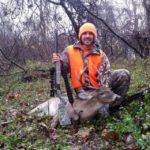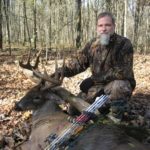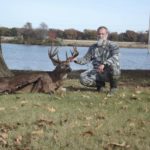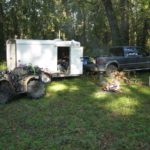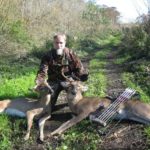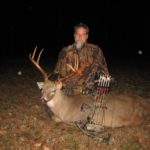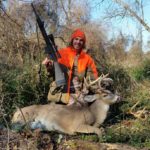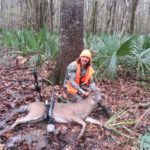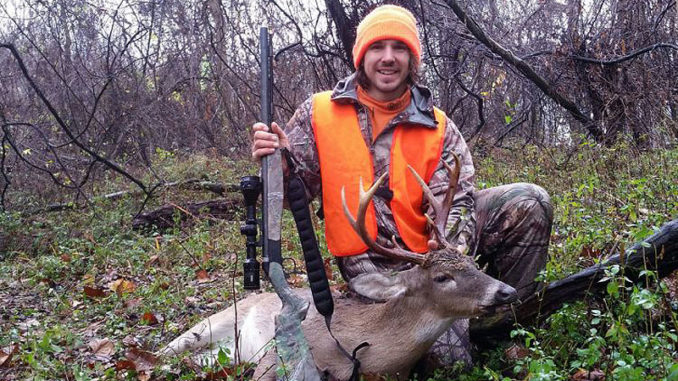
Some hunters choose to take advantage of Louisiana’s liberal deer season by traveling the state instead of getting bogged down on a lease. Here’s how they kill deer everywhere they go.
It was late summer near Concordia Parish. Temperatures hovering near the 100-degree mark coupled with dense humidity congested the air.
The trees, lush with green foliage, offered some shade, but provided little relief for ultra-marathon runner Josh Chauvin.
Chauvin, a diehard deer hunter, had spent the better part of the day running and hiking through a patch of public land not far from the Mississippi River and, by the end of the afternoon, he had covered more than 20 miles — just an average weekend for the 31-year-old.
The exercise was part training, part scouting trip. The sweltering, summer days, Chauvin said, offer the perfect opportunity to find deer sign on his favorite public hunting grounds while employing his unconventional scouting tactic.
“It’s easy to find old hookings and scrapes after the winter season,” Chauvin said. “I’m looking for thickets — real, real thick area.
“The more ground I cover running, the more spots I can find.”
Chauvin’s camp is located in Concordia Parish, a little more than three hours from his Thibodaux home. He considers himself lucky to have the place, which gives him access to thousands of acres of prime hunting land.
The large swath of acreage he actually hunts is all public land, consisting of areas including Sicily Island, Dewey Wills, and Richard K. Yancey wildlife management areas.
Chauvin’s camp only serves as a home base, but even if Chauvin had a parcel of property to call his own, there’s a good chance he’d hardly hunt it, anyway.
“It might take me five or six years before I harvest a deer in a spot because I don’t like to hunt an area too much,” he said. “I might only hunt it a handful of times a year — or one weekend — and I won’t hunt it again for two months or something, because human pressure really scares deer away.
“So, basically, if I don’t get lucky, I’m going to wait for the next year, for the right wind, the right weather (or) the right rut conditions to get in an area.”
Chauvin’s deer-hunting philosophy is to never stop scouting and never stop moving. He’ll hunt one WMA in the morning and hike miles away for an afternoon hunt; come the next day, he might be in another part of the state.
Chauvin said he knows plenty of hunters who get bogged down during deer season, sticking to a spot on a lease only to have minimal deer sightings.
That’s not something he’s interested in doing — and he’s not alone.
Berwick hunter Russell Scarbrough covers serious ground from north to south Louisiana in pursuit of whitetails and, like Chauvin, he doesn’t stop scouting — or moving around the state — during deer season.
“I travel around the state to try and stay in the rut as much as possible, but mainly I enjoy the challenge of hunting different terrains,” Scarbrough said.
Scarbrough’s point is insightful: Traveling around enables hunters to take advantage of several rut phases spanning the state, running from roughly September in the southwestern part of the state to the latest breeding action in Area 6 in February.
It’s possible for a hunter who travels enough to experience the rut virtually all deer season.
But traveling has other advantages, including abundant and accessible public land with healthy deer herds — although, as these hunters who don’t have a home base attested, hunting on the go isn’t for the faint of heart.
Scouting
Scarbrough said being a successful traveling hunter comes down to scouting more than you actually hunt. Like Chauvin, he scouts with an unconventional tactic, whether it’s the summer or the middle of deer season.
“Sometimes I just barge in (the woods) trying to jump deer up,” Scarbrough said. “If I do, I back out and analyze what I have learned, and then build a plan of attack. … (I)f they don’t blow at me during this time, I feel they are killable, and I’ll note the time they were in this spot, and I’ll kill them (there) the following day.”
Scarbrough also keeps five to six trail cameras deployed near his hunting grounds, and he checks them daily.
If he finds promising deer sign while poking around, he sets up a camera to catch any action; if there’s none, he’s off to another location that might offer a better chance at a kill.
“Deer are creatures of habit, and as long as everything they need is there for them — cover, food and water — they will repeatedly take the same routes over and over daily, as long as they are undisturbed,” Scarbrough said. “As soon as they lose one of the three things, they are gone.”
Springfield’s Josh Patterson gets most of his hunting done from November through January along the Mississippi River Delta.
But Patterson said that before anyone can think about scouting a WMA — let alone hunting there — you’ve got to make sure it’s a productive area.
“I contact biologists and talk to them about certain areas,” he said. “They’ll answer your questions and pull up harvest rates for management areas. I even went up to Baton Rouge and had them pull the harvest rate per management area up, and I looked for those with a high harvest rate per hunter effort.”
Patterson uses the data to make decisions on what WMAs are worth his effort based on the success of other hunters from seasons past. He said it gives him a piece of mind, knowing he likely won’t be wasting his time in an area.
So instead of worrying about the health of the deer herd, he can put all of his effort into finding deer sign and laying out a plan for the season.
Adapting
Moss Bluff hunter Shannon Clark’s hunting grounds vary widely during deer season. In one area, Clark might be surrounded by pines, while in another he’ll be in bottomland hardwoods.
And he said to be consistent in diverse habitat, it pays to understand what deer are feeding on and where they’ll be traveling.
“In a place like Clear Creek WMA, people want to climb a tree, but in that short pine you can’t climb,” Clark said. “So people won’t mess with that area because it’s too thick.
“But there’s a lot of deer in those areas.”
In the pine woods, Clark looks for American beautyberry, which deer eat due to the absence of acorns.
But, no matter where he’s hunting, Clark ensures he knows the natural food sources that are available.
Scarbrough keeps virtually all of his gear with him while he travels in his cargo trailer that he converted into a camper. With his full arsenal at his disposal, he doesn’t get stuck in a position where he can’t hunt the best deer sign.
“The equipment you use changes from area to area,” he said. “In the marsh, it’s short ladder stands and tripods. If you head to North Louisiana, its lock-ons, climbers and ground blinds.
“A man just has to use common sense and experiment with what works for him in each situation.”
Mobility
For Chauvin, remaining mobile in the woods is just as important as hunting multiple areas of the state.
He keeps as many as eight climbers hidden in the woods, which enables him to pick from one of his many spots he has scouted.
Depending on the wind, time of year, or hunter pressure, his options are plenty.
“I enter the woods at daybreak, so that way others don’t set up on me and I can always adjust before the prime hours really hit,” Chauvin said. “I have hundreds of trees I could hunt. With multiple spots, you can have deep locations that you know others won’t hit.
“No matter the wind, no matter the time of the year, you always have a good area to hunt that doesn’t have a lot of pressure.”
When Chauvin does harvest a deer, he said he doesn’t hunt that location again. In a sense, he feels he’s mastered the puzzle of how to locate and harvest the deer in a particular area, so he heads off to a new patch of woods.
“When I kill, it would be very easy to go back to the same area and kill again, but that doesn’t interest me,” he said. “What interests me is the hunt, the learning and the challenge of the next mission.”
Scarbrough said he’ll often move the location of his tree stand after every hunt. He said deer travel to different locations throughout the day, which requires an adjustment from the hunter.
“You can’t hunt the same locations in the morning that you hunt in the evenings,” he explained. “The trick is to constantly move around.”
On a lease or private land, picking out a spot on a food plot is the name of the game, but Scarbrough said public-land deer are always on the move due to pressure and ever-changing food sources.
So the hunter has to move with them to learn where they’ll be next, he said.
“Every time you hunt a different area you learn something about the local deer and their habits,” Scarbrough said. “The key is to capitalize on what you did learn and apply it successfully.”
Persistence
Scarbrough will tell you that, while taking a deer is one of the rewards of hunting, it’s not the reason he does it.
For him, all the traveling and countless hours behind the wheel, on the tree stand and in the woods, it’s about what leads up to the moment before the deer walks into his crosshairs.
“It takes commitment, drive and the love of the chase,” Scarbrough said. “I’m all about the chase. I’m the type of guy who can’t stand to not know what’s over the hill, even if I don’t need to go there.”
That sort of desire — and persistence — is the key to being successful no matter where you hunt. Each day spent hunting or scouting is an opportunity to learn and adapt.
As Chauvin rounded off his summer scouting trip, he returned to his camp tired and sweaty — but satisfied.
It was a productive day in which he was able to learn more about the deer in his presumptive hunting location.
That persistence is what sets him and those like Scarbrough apart from others. It’s why they’re able to continually harvest deer, whether they’re in the pines, the bottomland hardwoods or a cypress swamp.
And for Chauvin, hunting is more than access to free-range meat or a way to fuel an obsession with the sport: It’s a test of his character and determination, as well as an outlet to fulfill an insatiable desire for achievement.
It’s why Chauvin chooses public land over privately owned property, a different hunting location every hunt over a trusted food plot, and scouting by foot rather than on a four-wheeler.
It’s why he’s a traveling hunter.
“You can stick with what you know and you can continue to kill deer that way, but then you don’t grow much as a hunter,” Chauvin said. “Because I’m hunting different areas, I’m learning so much more than hunting a lease or hunting one unit.
“So being successful, to me, is me learning new strategies. The tougher it is, the more challenging the spot was to find (and) learn to hunt, the more rewarding a feeling I get when I do make a harvest.”
